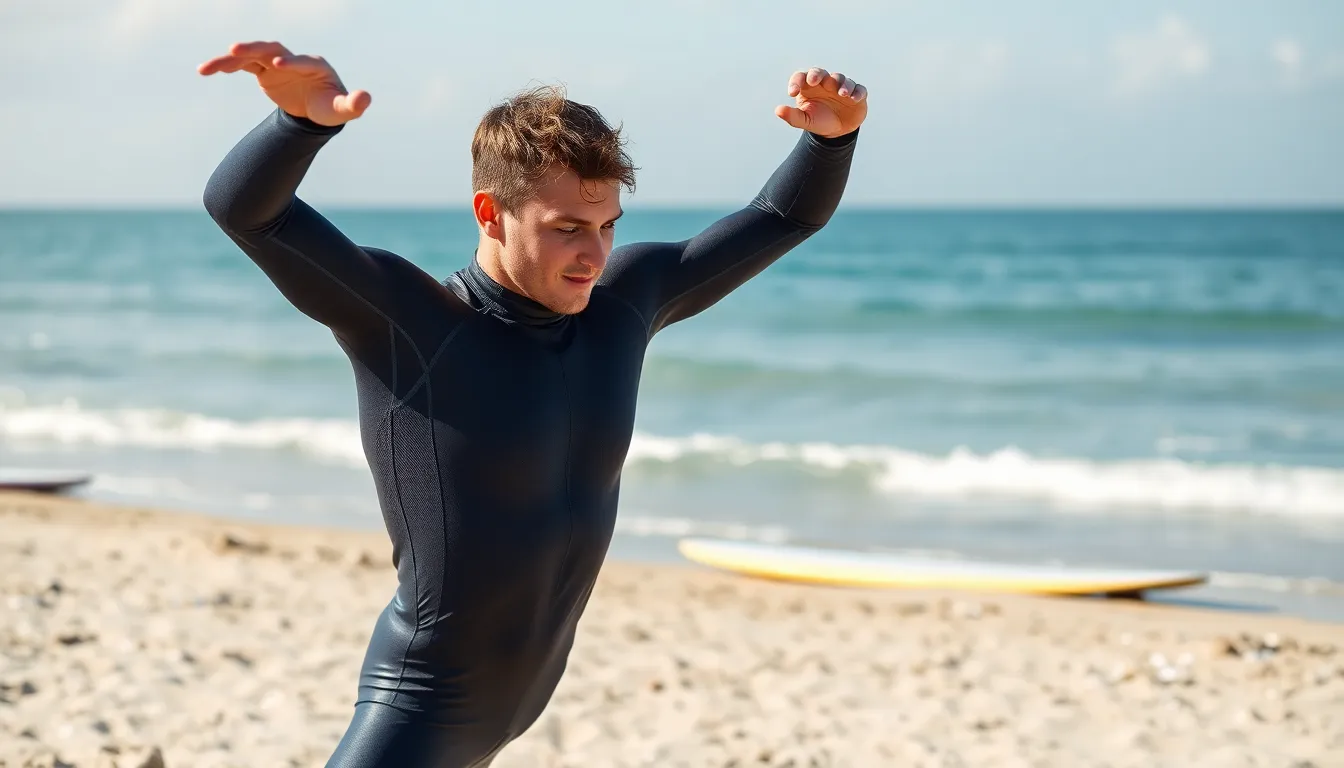Table of Contents
ToggleSurfing demands not only skill but also strength, flexibility, and endurance. A solid pre-surf workout can enhance performance and minimize the risk of injury. By incorporating specific exercises into a routine, surfers can prepare their bodies for the physical challenges of riding waves.
These workouts focus on core stability, balance, and overall fitness, ensuring surfers are ready to tackle any swell. Whether it’s paddling out or popping up on the board, a well-structured warm-up can make all the difference. Embracing a pre-surf workout routine can transform the surfing experience, leading to more enjoyable and successful sessions on the water.
Benefits Of A Pre-Surf Workout
Pre-surf workouts significantly contribute to enhancing overall performance while minimizing injury risk. Engaging in a structured routine helps prepare the body for the unique challenges of surfing.
Enhancing Performance
Enhancing performance involves improving strength, flexibility, and endurance. Pre-surf workouts target essential muscle groups, increase stamina, and improve cardiovascular fitness. Specific exercises, such as squats, lunges, and push-ups, build core strength. Strengthening the core allows for better paddle power and wave maneuverability. Moreover, incorporating dynamic stretches improves flexibility, enabling surfers to perform fluid movements on the board. Practicing balance exercises, like single-leg stands, enhances stability during rides. Increased agility and quickness contribute to better wave catching and riding experience.
Reducing Injury Risk
Reducing injury risk is paramount for surfers. Pre-surf workouts focus on preventing common injuries associated with surfing. By warming up muscles and joints, surfers enhance their flexibility and range of motion. Targeting the shoulders, back, and legs lowers the likelihood of strains and sprains. Core stability exercises, such as planks, protect the lower back and support proper posture in the water. Strengthening key muscle groups minimizes the impact of falls and collisions while surfing. Additionally, a structured warm-up routine improves overall body awareness, allowing surfers to respond effectively to unexpected changes in conditions.
Key Exercises To Include

Effective pre-surf workouts incorporate dynamic stretching and strength training to enhance performance and minimize injury risk. Below are essential exercises that improve flexibility, strength, and overall surfing ability.
Dynamic Stretching
Dynamic stretching activates muscles and increases blood flow, preparing the body for movement. Key dynamic stretches include:
- Arm Circles: Perform forward and backward arm circles to loosen shoulder joints.
- Leg Swings: Swing each leg forward and backward to stretch hip flexors and hamstrings.
- Torso Twists: Rotate the torso side to side to enhance spine mobility and engage core muscles.
- Walking Lunges: Step forward into lunges, alternating legs, to stretch quads and engage hip muscles.
Incorporating these dynamic stretches into a pre-surf routine improves flexibility and range of motion.
Strength Training
Strength training builds essential muscle groups crucial for surfing endurance and performance. Recommended strength exercises include:
- Squats: Perform bodyweight or weighted squats to strengthen the legs, glutes, and core.
- Push-Ups: Execute standard or modified push-ups to develop upper body strength, focusing on chest and arms.
- Planks: Hold a plank position to engage the core, build stability, and support proper posture.
- Deadlifts: Incorporate deadlifts using weights to strengthen the back, legs, and grip.
These strength-training exercises enhance overall muscle strength, contributing to more powerful paddling and better stability on the board.
Creating Your Pre-Surf Workout Routine
Establishing a pre-surf workout routine enhances performance and minimizes injury risk. Incorporate a blend of warm-up techniques and cool-down practices for optimal preparation.
Warm-Up Techniques
Incorporating effective warm-up techniques signals the body to prepare for strenuous activity. Specific dynamic stretches enhance mobility and engage key muscle groups.
- Arm Circles: Increase shoulder mobility and circulation.
- Leg Swings: Improve hip flexibility and leg muscles’ readiness.
- Torso Twists: Mobilize the spine and core for better balance.
- Walking Lunges: Activate lower body strength and flexibility.
These movements elevate heart rate while increasing blood flow to target areas, ensuring surfers are primed for wave riding.
Cool-Down Practices
Implementing proper cool-down practices aids in recovery and reduces muscle soreness. Specific methods focus on gentle stretching and breathing techniques.
- Static Stretches: Target major muscle groups like the shoulders, back, and legs to enhance flexibility.
- Foam Rolling: Release muscle tension and improve blood circulation.
- Deep Breathing: Promote relaxation and aid in mental recovery.
These practices help the body transition back to a resting state, facilitating quicker recovery and readiness for the next surfing session.
Tools And Equipment Needed
Several tools and pieces of equipment enhance the effectiveness of pre-surf workouts. These items support strength training and balance exercises, crucial for improved surfing performance.
Resistance Bands
Resistance bands provide versatile options for strength training and flexibility enhancement. These bands come in various resistance levels, allowing individuals to perform exercises that target muscle groups such as the shoulders, back, and legs. Utilizing resistance bands for exercises like rows, lateral raises, and chest presses increases muscle endurance pivotal for paddling and maneuvering on the board. The lightweight and portable nature of resistance bands makes them ideal for pre-surf workouts, whether on the beach or at home.
Balance Boards
Balance boards facilitate significant improvements in stability and core strength. These boards challenge the body’s equilibrium, forcing engagement of various muscle groups essential for surfing. Regular use of balance boards enhances coordination, proprioception, and core stability, leading to better performance on the waves. Surfers can incorporate exercises like squats, lunges, and balance drills on these boards, further preparing their bodies for the dynamic movements required during a surf session.
Pre-surf workouts are essential for any surfer looking to enhance their performance and minimize injury risk. By focusing on strength flexibility and endurance through targeted exercises surfers can prepare their bodies for the demands of the waves. Incorporating dynamic stretches and strength training not only primes the muscles but also builds the necessary core stability and balance.
Utilizing tools like resistance bands and balance boards can further elevate these workouts making them more effective. A well-structured routine that includes warm-ups and cool-downs ensures surfers are ready to ride and recover efficiently. Embracing these practices leads to a more enjoyable surfing experience and greater success on the water.




